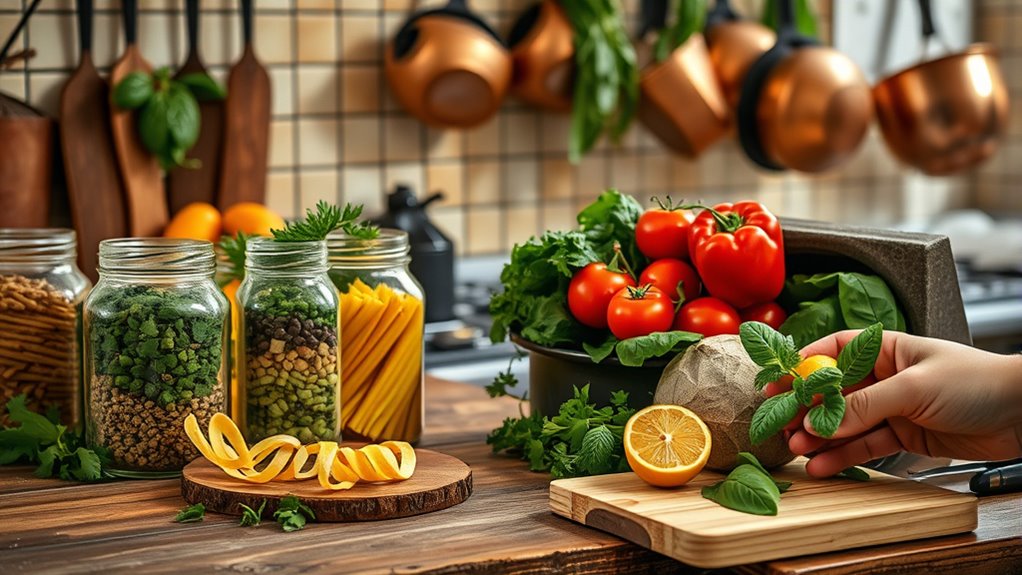To cut food waste at home inspired by Italian kitchens, start by planning your meals carefully around what you already have. Use vegetable scraps for broths and overripe fruits for jams or smoothies, adding flavor and variety. Compost kitchen scraps like coffee grounds and peelings to nourish your garden. Think of your kitchen as an Italian trattoria, valuing every ingredient—adopting these simple habits keeps waste low, saves money, and benefits the environment. Keep exploring to discover more practical strategies.
Key Takeaways
- Plan meals around existing ingredients and use shopping lists to prevent impulse buys that may spoil.
- Repurpose vegetable scraps and overripe fruits into broths, jams, or smoothies to extend ingredient use.
- Compost food scraps like coffee grounds, eggshells, and vegetable peels to reduce waste and enrich garden soil.
- Adopt Italian kitchen principles by valuing every ingredient and creatively using stems, peels, and leftovers.
- Practice mindful shopping and portioning to minimize leftovers, spoilage, and environmental impact.

Have you ever considered how much food you throw away each week? It’s easy to underestimate, but waste adds up quickly when you’re not mindful. Luckily, you can make a big difference by adopting simple practices inspired by Italian kitchens, where resourcefulness and respect for ingredients are key. One effective approach is meal planning. Instead of buying impulsively or sticking to a shopping list that doesn’t account for what you already have, plan your meals around ingredients you know you’ll consume. This helps you avoid buying excess food that might spoil before you use it. When you plan ahead, you also get a clearer picture of portions needed, reducing leftovers and minimizing waste.
In Italian cooking, the art of repurposing ingredients is second nature. Use vegetable scraps to make broths, or transform overripe fruits into jams or smoothies. This not only prevents waste but also adds flavor and variety to your meals. Incorporating meal planning into your routine means you’re less likely to toss out spoiled produce or unused leftovers. To further cut down on waste, explore composting tips. Composting is easy and a fantastic way to recycle food scraps like coffee grounds, eggshells, and vegetable peelings. You can set up a simple compost bin in your backyard or use a worm bin indoors if space is limited. Composting not only reduces trash but also creates nutrient-rich soil that can be used in your garden or houseplants. Additionally, choosing the right projector technology for your setup can enhance your viewing experience, making your home even more inviting for gatherings or quiet movie nights.
Adopting these habits requires a shift in mindset, but the payoff is significant. Think of your kitchen as an Italian trattoria, where every ingredient is valued and nothing goes to waste. When you plan your meals thoughtfully, you’re less likely to buy unnecessary items, saving money and reducing the load on your trash bin. Use your leftover vegetable stems and peels creatively—simmer them into broths or freeze extras for future use. Regularly practicing composting tips ensures that food scraps don’t end up in landfills, where they release harmful gases. Instead, they’ll nourish your garden or indoor plants, closing the loop on food waste.
Frequently Asked Questions
How Do Italian Kitchens Repurpose Leftover Ingredients Creatively?
In Italian kitchens, you creatively repurpose leftover ingredients by making creative ingredient swaps, turning yesterday’s bread into crispy croutons or stale pasta into a flavorful frittata. You use flavor enhancement techniques like adding fresh herbs, a drizzle of olive oil, or a splash of lemon to refresh dishes. This approach not only minimizes waste but also elevates your meals, making leftovers taste delightful and new.
What Are Traditional Italian Methods for Preserving Seasonal Foods?
You can preserve seasonal foods using traditional Italian methods like canning techniques and drying methods. For canning, you might preserve tomatoes and fruits in jars, sealing them to keep flavors intact. Drying herbs, tomatoes, or fruit is also common, often sun-dried or using low heat. These methods help you enjoy fresh flavors year-round, reduce waste, and stay connected to Italy’s culinary heritage while making the most of seasonal bounty.
How Can I Adapt Italian Recipes to Reduce Ingredient Waste?
Think of your kitchen as a vibrant Italian piazza, bustling with flavors and stories. You can adapt recipes by using ingredient substitutions, swapping out seasonal items for pantry staples. Practice portion control, serving just enough to enjoy without leftovers. This way, you honor Italian culinary spirit—celebrating freshness and tradition—while cutting waste. Your cooking becomes a lively dance, where every ingredient plays its part perfectly, leaving no food behind.
What Common Kitchen Tools Do Italians Use to Minimize Food Waste?
You’ll find Italians rely on essential kitchen tools like food storage containers and composting systems to minimize waste. Use food storage containers to keep leftovers fresh and prevent spoilage, while composting systems help turn vegetable scraps into nutrient-rich soil. These tools encourage thoughtful use of ingredients, reduce waste, and support sustainable cooking habits, making your kitchen more eco-friendly and efficient.
How Do Italian Households Plan Meals to Avoid Excess Leftovers?
You plan your meals carefully by doing meal prepping and creating a detailed shopping list to avoid excess leftovers. Italian households often organize their weekly menus, focusing on versatile ingredients to minimize waste. By shopping intentionally and preparing meals in advance, you guarantee you buy only what you need, cook appropriate portions, and reduce food waste. This mindful approach makes your kitchen more sustainable and helps you enjoy fresh, delicious meals every day.
Conclusion
By adopting these simple tips, you’ll naturally cut down on food waste and save money, just like many Italian kitchens do. Sometimes, it’s the small, mindful choices—like repurposing leftovers or planning meals—that make the biggest difference. It’s funny how a few conscious habits can unexpectedly align, turning your kitchen into a place of both efficiency and tradition. Ultimately, reducing waste becomes more than just a task—it’s a way to connect with life’s simpler, more meaningful moments.








